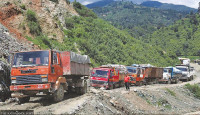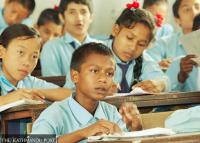Opinion
Prolonged stalemate
It is perhaps time to turn to an approach where all major parties agree to work with a common mediator
Deepak Thapa
An outcome that was all but certain played itself out in Saptari three days ago. An adamant UML coming head to head with an equally uncompromising Samyukta Loktantrik Madhesi Morcha (SLMM) resulted in the unfortunate death of four protestors in Rajbiraj. As often happens, recriminations have begun to fly and everyone is trying to pin the blame on someone else.
With this outbreak of violence and the likely unrest to follow, Nepal has once again been plunged into the all-too-familiar uncertain territory. What that means for the planned local elections remains to be seen, but the incident has certainly managed to drive a deeper wedge between the UML and the SLMM—the two sides have to come to an understanding if the country is to move past this prolonged phase of political transition.
Incomplete amendment
There is no doubt that the hubris of the Nepali Congress-UML-Maoist combine in ramming through a constitution in the face of sustained resistance in the Tarai is to blame for the morass the country is presently in. It has been just a year since the blockade along the Nepal-India border came to an end, and prior to that, there was a particularly violent period that saw the loss of lives by the score. It is baffling that our politicians have not learnt any lessons from recent history.
It is undeniable that the 2015 Constitution is a contested document and the one amendment so far, in January 2016, only served to buy us some time. All it did was amend two clauses with the hope of winning over the disgruntled groups. First, it ensured representation of all marginalised groups in public bodies following the ‘principle of proportional inclusion’ as opposed to the earlier formulation of only the ‘principle of inclusion’. It is a different matter that by retaining the number of groups eligible for this provision its purpose has been diluted to a meaningless sop. To remind readers, this is the complete list—‘economically, socially and educationally backward women, Dalits, indigenous nationalities, Madhesis, Tharus, minorities, persons with disabilities, marginalized communities, Muslims, backward classes, gender and sexual minorities, youths, farmers, labourers, oppressed or citizens of backward regions and indigent Khas Arya’. To understand how futile that provision actually is, one has only to look at the appointments made by both governments that have come to power since.
Second, it undertook to ensure that the Constituency Delimitation Commission would consider ‘population and geography’ instead of ‘geography and population’ while delineating the 165 constituencies for election under the first-past-the-post system. But, the SLMM’s other concern about geography—redrawing of the provincial boundaries—was put off for later, and it has now come back to haunt us. No one seems to know what the solution to this impasse is, and for the first time, even political pundits are able to sputter nothing more than the need for talks.
Talks for what?
The position adopted by the SLMM is difficult to comprehend. When the second amendment proposal was introduced last November, it was vehemently opposed by the SLMM. Now, it is equally vehement in demanding that the amendment be passed, otherwise threatening to obstruct the proceedings of the local elections. As usual, the SLMM has not cared to explain what changed in these past few months to account for just a dramatic shift in its stance. You can either be for something or against it. Seasoned politicos as the SLMM leaders are, they should know the simple maxim that you cannot have your cake and eat it at the same time.
That is perhaps why endless rounds of talks have resulted in absolutely nothing since there is nothing to talk about. The SLMM wants a redrawing of the provincial boundaries and the UML (and its surrogates) are totally against it. One has to be thankful that at least we have not reached a stage where either side refuses to talk to the other, and it is heartening to see individuals from both camps continuing to behave more than civilly with each other on occasion as well. But one does wonder why the prime minister even insists on hosting those conclaves at Baluwatar since they have proved to be no more than exercises in futility that end in a restating of respective positions over and over again.
Is anyone ready?
We have reached a classic stage of stalemate and are at the end of the tether in terms of what our leaders are able to achieve. I have previously argued in these pages that what we sorely need is a professional mediator, either an institution or an individual of whom there are many around the world, to bring all sides to a common understanding of this intractable problem and a common resolve to find a solution. Such mediators have been active in the past, particularly in the run-up to and after the 2006 political change. And, while there were some successes, in totality it resulted in no significant change in the fundamentally opposed stances of the antagonists.
That is partly because the field was just too crowded. As Teresa Whitfield writes in her very insightful 2008 publication, ‘Masala Peacemaking: Nepal’s Peace Process and the Contribution of Outsiders’: ‘A proliferation of international actors was in itself confusing for their Nepali counterparts, who accepted the multiple offers of assistance with goodwill, even as they found the fragmentation of their partners, and their sensitivity towards closer collaboration confusing…[the human rights activist and peace negotiator] Padma Ratna Tuladhar saw all the outsiders come and go…He recalled constantly trying to encourage his foreign friends to work together. But his efforts were to no avail. “I suppose it is just not in their culture,” was his somewhat rueful conclusion.’
Outsiders included individuals, organisations and countries, all competing with each other to take credit should the peace process end happily, while Nepali politicians were all too willing to go along with any and every one. Whitfield is generous when she says ‘with goodwill’, and though that may indeed be the case, there is no denying the attraction of the perk that came with involvement in these efforts in the form of meetings in foreign locales. With so much that went on concurrently, and perhaps contradictorily as well, it is no surprise that the decade-long debate on the constitution is far from over.
Now that we have learnt what works and what does not, it is perhaps time to go back to that approach, where all the major parties concerned work with one such mediator. This will also mean that all the factions within each of the parties have to be in agreement on the selection of representatives from their parties to negotiate on their behalf, no matter how long it takes. Most importantly, it will require that the top leadership of all the parties are open to any kind of give and take that may be required to lead the country to peace. That requires statesmanship. Wonder if there is anyone ready to step up to the plate?




 17.12°C Kathmandu
17.12°C Kathmandu










